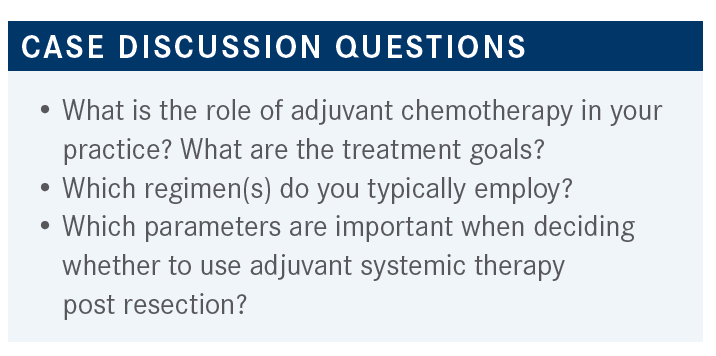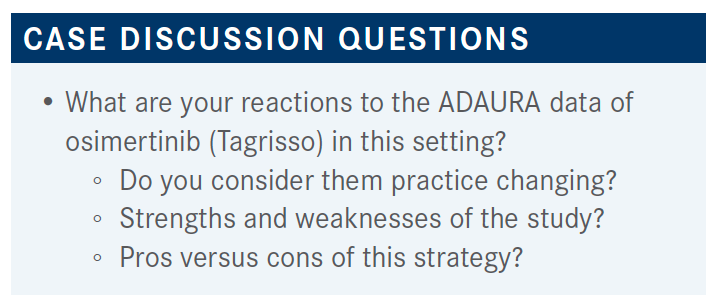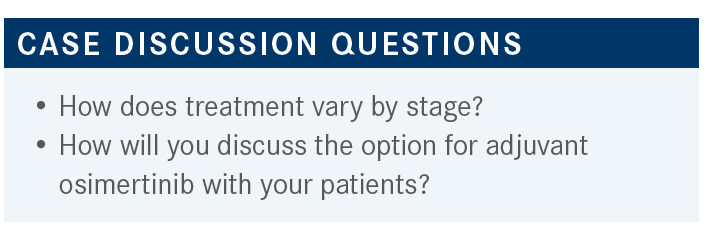Roundtable Discussion: Finding Targets for Adjuvant NSCLC Treatment
Corey J. Langer, MD, led a peer discussion around novel targets for adjuvant non–small cell lung therapy.
Corey J. Langer, MD

Corey J. Langer, MD, director, Thoracic Oncology at Abramson Cancer Center and professor of Medicine at Hospital of the University of Pennsylvania, led a peer discussion around novel targets for adjuvant non–small cell lung (NSCLC) therapy during a virtual Targeted Oncology Case-Based Roundtable event.
Langer was accompanied by other oncologists in Pennsylvania and New Jersey including:
- Tami l. Bach, MD
- Yacoub g. Faroun, MD
- Elhamy eskander, MD
- Bill gai, MD, PhD
- Judit gellen, MD
- Qamar zaman, MD
- Gurprataap Singh Sandhu, MD
- Neenos Alnoor, MD
- Daniel Afiom-Ekaha, MD
- Mary A. Simmonds, MD
- Jose A. Silva Jr, MD
- Nalini Mehta, MD
- Mariya Apostolova, MD

LANGER: Are tests ordered by the medical oncologist or are the surgeons doing it? Do you do reflex testing or does the CMS rule affect you?
BACH: The only challenges that I have with testing are where we’re going to send it and who is going to pay for it. I think, nowadays, our community hospital [does not] routinely test and we must ask for it. Sometimes we retrieve the tissue and send it off to a third-party commercial lab. Our community hospital now uses NeoGenomics Laboratories testing.
We can retrieve [tissue] and send tests anywhere. A lot of times we’re sending to…BioReference Laboratories.
For patients with EGFR [as a target], the phase 3 ADAURA [NCT02511106] trial, and with [osimertinib (Tagrisso)] now, I think we’re going to be the ones who are treating these patients post resection but with the later-stage patients we are the ones who are in charge.
It’s not like how at [much larger hospitals] it just automatically gets done. I think we must intervene. When the pulmonary [department] orders surgery, I think they’re calling us also to ask what the molecular tests are [that] we must order at this point and how it is going to change management. I haven’t done it as much with the resectable ones yet, but certainly for the later stage I think the medical oncologist is in charge.
LANGER: Is there a delay in getting it because of the CMS rule, or are you able to order right off the bat if you see them post operation?
BACH: I think in-house if it’s within a 14-day window that the hospital will be able to cover the cost for that. I don’t know about the CMS rule, but [perhaps] that’s what that reflects.
Right now, I think I’m seeing somebody right at 14 days who is being sent to me. I just got called by the pulmonary [department], so I must ask the pathologist if I can still do that, because we’re within 14 days. Otherwise, I’m probably going to wind up retrieving [a sample] before I even see the patient and getting it sent off to a third party.
I tend to not like NeoGenomics as much, as far as their panels go, the reports and the ease at which we can get that, and PD-L1 testing, not necessarily for this patient but for the NGS [next-generation sequencing] testing. I think I like our FoundationOne and BioReference [tests] that I’ve seen. Being able to have control of that through our own office and sending out either liquid biopsies or retrieving tumors—I think we must ask for it from the pathologist. Then it does fall within that CMS rule when we’re asking for it, and we send over a prescription to get it done.
FAROUN: [I want to] echo what [Dr Bach] said, that we initiate the NGS ordering by medical oncologists. Our pathologists don’t have any tests to do on stage I to stage IV, so we order the test and usually I like to order on tissue biopsy. This one is a huge biopsy, so I can send a [part] of the biopsy to Sienna Cancer Diagnostics and we have the results between 10 and 15 working days.
LANGER: There’s less of an urgency here because they need to recover. There’s an indication for adjuvant treatment and we’ll discuss that in this situation. If you’re going to initiate anything, it won’t be until after the adjuvant chemotherapy is done.
ESKANDER: For metastatic lesions our pathologist ordered the panel, but for early stage the medical oncologist must order that. So we are the ones who takes care of the ordering.
GAI: Our pathologist started ordering the tests, the NeoGenomics, so that gets everything, basically, for patients with early-stage or metastatic [disease].
LANGER: So they’re doing it; you don’t have to order it?
GAI: Yes, that’s something new; it started in the last couple [of] months. We used to be ordering by ourselves, especially in the early stage, but I was not urging CT orders in early stage most of the time.
LANGER: They do that at your behest, or they did this on their own?
GAI: They are doing it on their own now.
LANGER: Very interesting. I must tell you, that’s not the norm but it’s encouraging.
FAROUN: If the patient’s pathology is squamous cell cancer instead of adenocarcinoma, do you usually send for tests?
LANGER: Not routinely, not for squamous cell cancer, although I think there will come a time where we will. But right now, no.

GELLEN: For a patient with stage IB NSCLC [non–small cell lung cancer], probably the performance status and histology. The poor-risk features are more important as far as trying to convince the patient whether they should take adjuvant [therapy]. If it’s a higher-stage patient, I definitely try to convince them to take adjuvant chemotherapy; the discussion is about the benefit, what are their chances of tumor [shrinkage], and the lower risk of complication from the adjuvant chemotherapy.
LANGER: If somebody has a smaller tumor, say 3 cm, node-negative, of lymph vascular invasion and poorly differentiated, would you treat that person or would you hold back?
GELLEN: I will treat that person. I think it also depends on their performance status. If you have a frail, older patient with a smaller tumor and [good] features, I would be less likely to. I will present them the option of doing chemotherapy or doing adjuvant therapy but would be less forceful to push them toward taking the treatment.
ZAMAN: For visceral pleura invasion, does your radiation oncologist give any localized radiation after you finish the chemotherapy?
LANGER: Not for visceral invasion. Maybe for something going into the chest wall, in which case it’s automatically upstaged to T3. Visceral invasion is controversial. There are some retrospective studies that show increased risk for relapse, but many others that show that tumor size really governs relapse with visceral invasion—so if it’s a 3-cm tumor, visceral only, no parietal pleura, no pleura differentiation, no lymphovascular invasion, then I’ll frequently leave that patient alone. If they have 4.5 or 5 cm, I’d tend to treat that person. I think lymphovascular invasion is another story. We don’t have the data. My heart says yes; my head says where are the data? So I’ll have a pointed discussion in the absence of node involvement.
SANDHU: Any patient stage I, stage II, or stage IB even, if they have a good performance status, I at least have a discussion about chemotherapy and adjuvant chemotherapy. The advantage is not huge, maybe 5% or 10% [more], so some people opt to not go for chemotherapy. With radiation, we typically have a discussion if the margins are positive and go from there, then refer those patients to the radiation oncologist.
LANGER: So you will routinely treat someone whose tumor is larger than 4 cm?
SANDHU: Correct, so even if they’re node-negative, even those patients are off their adjuvant chemotherapy.
ESKANDER: Have you ever tried the test DetermaRx to decide on a need for chemotherapy?
LANGER: I’m going to answer the question 2 different ways. The size issue is all retrospective data. We have no prospective trials that have separately shown a definitive survival advantage for adjuvant chemotherapy just based on size of the tumor. There were retrospective data from a trial that looked at paclitaxel compared with carboplatin, and the weight of data was stronger when it was 6 cm or 7 cm, not 5 cm. Then in a separate retrospective analysis from the BR10 trial [NCT00002583], which used vinorelbine [Navelbine] plus cisplatin—a regimen I don’t think any of us use these days for adjuvant therapy— 4 cm was the magic number.¹ Larger than 4 cm, the hazard ratio for survival was 0.66, and for smaller than 4 cm it went in the wrong direction, the hazard ratio was above 1. Patients did better if they didn’t get chemotherapy.
With the Oncocyte DetermaRx, there are a number of companies now that are starting to look at both tissue markers, so usually based on...tumor mutation burden [TMB], certain mutations, and then also circulating tumor DNA [ctDNA]. This unsurprisingly shows if the patient either has a poor [prognosis] on an Oncocyte-type platform or if post resection, they have ctDNA, they are bound to do badly. The problem is we have no prospective data yet, showing that adjuvant [treatment] in that situation is going to change outcome.
ALNOOR: My approach for stage II disease is I usually recommend chemotherapy, especially if it’s a young, healthy person and kidney function’s good. I usually use cisplatin and pemetrexed [Alimta]. For stage IB, I really don’t push for that. I look at the data, and I really [try to] pick my recommendation on that. I look at the size and other factors, but usually if it’s a young patient I try to support that approach to chemotherapy; otherwise I will not push for it. With most patients, if it’s a small [tumor] and visceral metastasis, they decide they’re not going to go for chemotherapy.
LANGER: Do you have an age cutoff [for this approach]?
ALNOOR: Usually, 65 and above. Usually performance status is more important, but [for patients] 65 and above, I try not to push for chemotherapy much.
LANGER: You bring up an important issue. There’s a retrospective analysis by Carmela Pepe, MD, of the BR10 trial, that showed 75 years was the [ideal age].² Above 75 years, the numbers were so small and the data were poor regardless of whether they got adjuvant treatment or not. You could make an argument that above 75 years, we’re in a data-free zone, but, intriguingly, between 65 and 75 years, the survival advantage was every bit as good as under 65 years. So I think, at least for adjuvant, 65 years seems to be [ideal].

EFIOM-EKAHA: I would use adjuvant radiation for patients with positive margins and lymph node involvement [such as patients with angiosarcoma as well].
ZAMAN: [I would factor in] the resection margin and N2 disease.
SIMMONDS: I would agree with the other 2 oncologists there. We have good radiation oncologists, as far as they would not radiate if they thought they shouldn’t.

SILVA: I think [the ADAURA regimen is] clearly practice changing and we should be using this moving forward. The benefit for those patients is probably going to be even superior to the benefit of the chemotherapy itself, and I’m already testing patients as they’re finishing chemotherapy to see if they’re going to get the regimen on top of chemotherapy.
LANGER: Would you give it to everyone, or just patients with stage II and IIIA [disease]?
SILVA: I probably will give it to everyone.
MEHTA: I think it’s impressive data and I’m sure all my medical oncology colleagues would consider doing it more often, especially in [patients with stage III disease and EGFR mutations].
APOSTOLOVA: [This is] a practice-changing trial, and I would consider it even for earlier-stage patients. In terms of the CNS [central nervous system] progression, I also wanted to ask a question. I had a few patients, not EGFR positive, where they had CNS progression and despite multiple treatments there isn’t much that we could do. Is there anything that you would do differently for those people, where systemic disease was controlled and they only had CNS progression?
LANGER: The advantage here, at least, has been the patients who get osimertinib, it seems to be protective although some of them did have CNS progression.3 You’re sort of stuck. You can go to the double dose of osimertinib at that point, the BLOOM [NCT02228369] trial suggested that for carcinoma meningitis there might be some benefit. But [patients on the ADAURA trial] had resection and didn’t have CNS disease, at least at that point.4 So, it seems to be protective.
We also know that it can cross the blood-brain barrier. All of us have seen patients with brain metastases whose tumors have responded in the brain without radiation, so the benefit, I think, is striking.
ESKANDER: We always use the targeted therapy in the metastatic setting first, before we talk about chemotherapy. How do you explain that there’s more benefit for those folks who got chemotherapy then the targeted therapy?
LANGER: Excellent question, and I don’t think we have a good explanation. The majority of those [patients] who had stage II or IIIA [disease] did get chemotherapy, and we have better data for that group. I think it may be the lingering benefit of the chemotherapy. These were higher-risk patients, so it may be the TKI [tyrosine kinase inhibitor] is going to work better in that higher-risk group. Whereas [in patients with stage] IB, a fair number of those patients are cured anyway with surgery alone. It’s unclear whether adding anything at all, whether it’s chemotherapy or TKI, is going to make a difference, but I have no good explanation.
It’s intriguing, and I think it underscores the fact that you can’t abandon one or the other. You probably need to do both. If you have node-positive disease, you need adjuvant chemotherapy and you strongly consider adjuvant TKI.

LANGER: In the absence of survival benefit, with the impressive hazard ratio in patients with stage IB disease and 3 years’ worth of low-grade but continuous toxicity, would you give osimertinib to patients with stage IB disease?
GELLEN: I think it will have to be a patient who is motivated and willing to go through the adverse effects. But now that we’re going to do NGS on the patients with early lung cancer [more] frequently, we’re going to find other mutations, and what do we do about that?
LANGER: It is uncharted territory. A lot of folks will say osimertinib works well in [patients whose tumor has an] EGFR mutation, when alectinib [Alecensa] or other TKIs work well in the ALK-positive setting and others.
Now, there is a proposal [for a trial] that will take all comers, and basically do an appropriate TKI match to the molecular abnormality versus placebo or observation in that group. I don’t know when that trial is going to start. I personally would need to see those data before I just empirically give folks adjuvant TKI for other molecular aberrations. Although I’m sure I’ll violate that rule, particularly if they have multistation node involvement, or extracapsular spread or something else that spooks me, that makes me worry that they’re destined to relapse. But that’s a very important question, and there are no data for that.
ZAMAN: What’s the difference [between EGFR exon 21 compared with exon 19 mutation responses]?
LANGER: The data were a little bit more impressive for [patients whose tumor had an] exon 19 mutation, but the confidence intervals were still well below 1.00 for exon 21 mutations.5 You see the same pattern in metastatic disease, that exon 19 seemed to have more profound and more durable responses. It may be the nature of the mutation, but they still benefit; the differences are much less than I might imply.
ALNOOR: How about immunotherapy for those patients? Did somebody try chemotherapy and immunotherapy for resected cancer?
LANGER: There are studies ongoing. The ALCHEMIST [NCT02194738] trial included a sub-trial called ANVIL [NCT02595944] where they took patients with stage II and IIIA [disease], specifically non-EGFR and non-ALK positive, and randomly assigned them to nivolumab [Opdivo] versus placebo. The trial is completely accrued; it has well over 900 patients and it’ll probably be another year or 2 before we see the data. We’re going to see similar trials in the neoadjuvant setting, but we have no data yet, good or bad, for immuno-oncology and resected patients.
References:
1. Winton T, Livingston R, Johnson D, et al; National Cancer Institute of Canada Clinical Trials Group; National Cancer Institute of the United States Intergroup JBR.10 Trial Investigators. Vinorelbine plus cisplatin vs. observation in resected non-small-cell lung cancer. N Engl J Med. 2005;352(25):2589-2597. doi:10.1056/NEJMoa043623
2. Pepe C, Hasan B, Winton TL, et al; National Cancer Institute of Canada and Intergroup Study JBR.10. Adjuvant vinorelbine and cisplatin in elderly patients: National Cancer Institute of Canada and Intergroup Study JBR.10. J Clin Oncol. 2007;25(12):1553-1561. doi:10.1200/JCO.2006.09.5570
3. Herbst RS, Tsuboi M, John T, et al. Osimertinib as adjuvant therapy in patients (pts) with stage IB-IIIA EGFR mutation positive (EGFRm) NSCLC after complete tumor resection: ADAURA. J Clin Oncol. 2020;38(suppl 18):LBA5. doi:10.1200/JCO.2020.38.18_suppl.LBA5
4. Yang JCH, Kim SW, Kim DW, et al. Osimertinib in patients with epidermal growth factor receptor mutation-positive non-small-cell lung cancer and leptomeningeal metastases: the BLOOM study. J Clin Oncol. 2020;38(6):538-547. doi:10.1200/JCO.19.00457
5. Wu YL, Tsuboi M, He J, et al; ADAURA Investigators. Osimertinib in resected EGFR-mutated non-small-cell lung cancer. N Engl J Med. 2020;383(18):1711-1723. doi:10.1056/NEJMoa2027071
